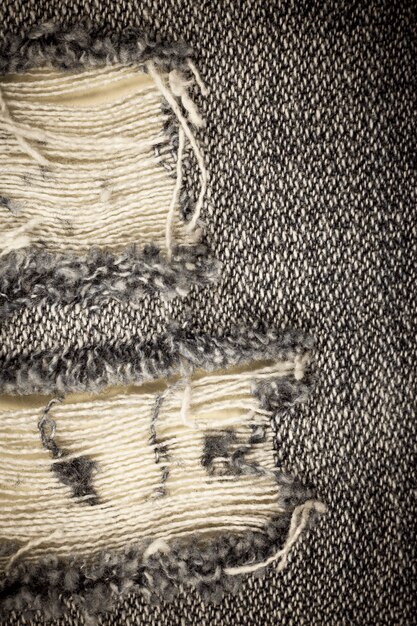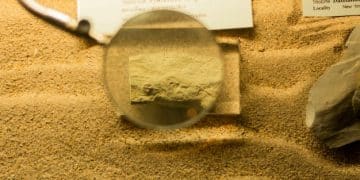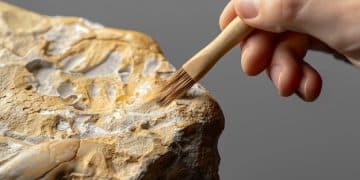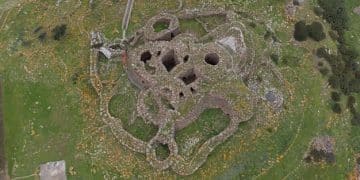Dating US Ancient Textiles: New Fiber & Dye Analysis

Advanced scientific methods are revolutionizing the understanding and dating of ancient textiles from US archaeological sites, providing unprecedented insights into historical fiber cultivation, dye production, and cultural practices.
The study of ancient textiles offers a unique window into past societies, revealing much about technology, trade, and daily life. However, accurately dating these delicate artifacts and understanding their composition has long posed significant challenges. New techniques for analyzing fibers and dyes from US archaeological sites are now revolutionizing our approach to dating ancient textiles: new techniques for analyzing fibers and dyes from US archaeological sites, promising unprecedented precision and depth of insight.
The Quest for Accuracy: Why Dating Ancient Textiles Matters
The enduring presence of ancient textiles in archaeological records, though often fragmented and degraded, stands as a testament to the ingenuity and daily lives of past societies. These fibrous remnants, whether simple cords or elaborate fabrics, offer invaluable insights into resource utilization, technological capabilities, and cultural expressions. Accurately pinpointing their creation date and understanding their material composition is not merely an academic exercise; it’s fundamental to reconstructing historical narratives with greater precision.
Dating textiles can be particularly challenging due to their organic nature, making them susceptible to decay and contamination. Traditional methods often rely on contextual associations—what other artifacts were found alongside them. While helpful, this approach lacks the specificity often needed to differentiate between continuous use, heirloom pieces, or even later additions to a site. The evolution of scientific techniques provides a more direct and reliable pathway to understanding these fragile remnants, moving beyond inference to empirical evidence.
Understanding the Context of Textile Preservation in North America
Textile preservation in the archaeological record is highly dependent on environmental conditions. In the United States, diverse climates lead to varied preservation outcomes. Arid regions, like the Southwest, offer excellent preservation for organic materials, yielding a richer textile record. Conversely, humid and temperate areas often see rapid degradation of fibers, making discoveries rare and their study even more critical.
* Arid Climates: Natural mummification and desiccation prevent microbial decay.
* Wet/Anaerobic Environments: Bogs and waterlogged sites can preserve textiles by starving decomposing microbes of oxygen.
* Sheltered Dry Caves: Protection from direct weather exposure prolongs textile life.
The scarcity of well-preserved textiles amplifies the importance of every discovery. Each fragment holds potential keys to understanding ancient economies, trade networks, and social structures. For instance, tracing the origins of specific fibers or dyes can illuminate interactions between distant communities.
Beyond Carbon-14: The Limitations of Traditional Dating
While radiocarbon dating (Carbon-14) remains a cornerstone of archaeological dating, it presents specific challenges when applied to textiles. A sample must contain sufficient organic carbon, and the age determined is for the plant material itself, not necessarily the exact moment of textile creation. Contamination from modern sources or mixed samples can also skew results, requiring meticulous pre-treatment.
Moreover, C-14 dating provides an age range, which can sometimes be broad. For fine-grained chronological studies—like tracking shifts in weaving techniques over decades rather than centuries—a more precise dating mechanism is often desired. This drives the innovation in techniques that analyze the fibers and dyes themselves at a molecular level. The aim is to achieve higher resolution dating and to gain deeper insights into forgotten crafts and their cultural significance.
Revolutionizing Fiber Analysis: Beyond Visual Identification
For centuries, textile analysis primarily relied on macroscopic and microscopic examination to identify fiber types. While useful for distinguishing between common materials like cotton, wool, or linen, this approach often fell short when dealing with highly degraded samples, unusual plant fibers, or when more precise species identification was required. The advent of advanced analytical techniques has transformed this field, allowing for molecular-level understanding of ancient fibers.
Spectroscopic Methods: Unveiling Molecular Signatures
Spectroscopy involves studying the interaction between matter and electromagnetic radiation. For fibers, this means exposing them to specific wavelengths of light and observing how they absorb, transmit, or reflect that energy. Each type of fiber—plant-based cellulose, animal-based protein—has a unique “fingerprint” of molecular bonds that respond differently, providing a chemical signature.
* Fourier-Transform Infrared (FTIR) Spectroscopy: This technique is non-destructive and rapid. FTIR identifies the chemical bonds present in a fiber by measuring how infrared light is absorbed. Different types of cellulose (e.g., cotton vs. linen) or protein (e.g., wool vs. hair) exhibit distinct IR spectra, allowing for identification even in highly degraded states.
* Raman Spectroscopy: Similar to FTIR, Raman spectroscopy provides molecular vibrational information. It is particularly useful for identifying specific components within a fiber and can distinguish between different forms of cellulose, helping to identify plant species. It is also less sensitive to water, which can be an advantage for certain samples.
These spectroscopic methods are invaluable because they provide objective data on fiber composition without destroying the precious artifact. They are particularly effective for fragmented materials where visual identification is ambiguous.
Chromatographic Techniques for Plant Residues
Beyond the primary fiber itself, ancient textiles can retain residues from their processing—plant oils, resins, or sizing agents. Chromatographic techniques excel at separating and identifying the individual chemical components within these complex mixtures.
* Gas Chromatography-Mass Spectrometry (GC-MS): This powerful technique separates volatile and semi-volatile compounds and then identifies them by their unique mass spectra. For textiles, GC-MS can detect lipid residues (fats, waxes) that might indicate the use of specific plant treatments or the environment in which the textile was stored.
* High-Performance Liquid Chromatography (HPLC): HPLC is used for non-volatile compounds and can separate complex mixtures into their individual components. It’s particularly useful for analyzing the degradation products of cellulose, offering insights into the preservation conditions and potentially the age of the fiber.
These methods enable researchers to move beyond simply identifying the fiber type to understanding the entire life cycle of the textile, from plant cultivation to its final use and deposition in the archaeological record. The molecular data provides crucial context for dating and interpreting the artifact.
The Archaeology of Color: Advanced Dye Analysis
The vibrant hues of ancient textiles were not merely decorative; they held profound cultural, social, and economic significance. Analyzing the dyes used provides critical information about trade routes, available plant resources, technological sophistication, and even cultural affiliations. However, deciphering ancient colors is often more challenging than fiber identification, as dyes tend to fade and degrade over millennia. New analytical techniques are bringing these lost palettes back to life.
Unlocking Pigments with Microscopy and Spectroscopy
Traditional methods of dye identification involved destructive chemical tests on small samples. Modern approaches prioritize non-destructive analysis and microscopic examination combined with advanced spectroscopy.
* Micro-Raman Spectroscopy: This technique allows for the analysis of tiny dye particles directly on the fiber. Because Raman spectroscopy can distinguish between different molecular structures, it’s highly effective at identifying specific organic and inorganic pigments. For example, it can differentiate between various red dyes like madder (from plants) and cochineal (from insects).
* UV-Vis Spectroscopy (Ultraviolet-Visible Spectroscopy): While less specific for exact dye identification, UV-Vis can provide information on the class of dye present and its concentration. It measures the absorption of light in the UV and visible range, which is characteristic of chromophores (the color-bearing parts of molecules).
* Scanning Electron Microscopy with Energy Dispersive X-ray Spectroscopy (SEM-EDS): While SEM provides high-resolution images of fiber surfaces, EDS simultaneously analyzes elemental composition. This is particularly useful for identifying inorganic pigments (e.g., mineral-based reds or blues) that contain specific elements like iron, copper, or manganese.
These techniques allow for the detailed examination of incredibly small samples, sometimes even single fibers, without causing significant damage to the artifact. This is crucial for rare and fragile ancient textiles.
Liquid Chromatography-Mass Spectrometry (LC-MS) for Organic Dyes
For the precise identification of organic natural dyes (the vast majority found in ancient textiles), LC-MS has become an indispensable tool. This technique separates complex mixtures of dye molecules based on their chemical properties and then identifies them by their unique mass-to-charge ratio.
LC-MS can detect individual dye compounds, such as morindone (from madder), carminic acid (from cochineal), or indigotin (from indigo), even when present in trace amounts or after significant degradation. This level of precision allows archaeologists to:
* Identify geographical origins: Specific dye plants are native to certain regions, helping to pinpoint trade routes or cultural exchanges.
* Reconstruct dyeing processes: The presence of specific dye components can reveal details about how ancient artisans extracted and fixed colors onto fibers.
* Track technological advancements: The shift from one dye source to another over time can indicate innovations in agricultural practices or dyeing techniques.
The ability to accurately identify natural dyes provides invaluable evidence for understanding ancient economies, artistic traditions, and cross-cultural interactions across US archaeological sites.
Amino Acid Racemization (AAR): A Novel Dating Approach for Protein Fibers
While radiocarbon dating measures the decay of carbon isotopes, Amino Acid Racemization (AAR) offers a complementary dating method, particularly powerful for materials containing proteins, such as animal fibers (wool, hair). This technique relies on a fundamental biochemical process that occurs after an organism dies.
The Science Behind AAR
Proteins in living organisms are typically composed of “L-amino acids.” After death, these L-amino acids slowly and predictably convert into their non-biological mirror images, “D-amino acids,” through a process called racemization. The rate of this conversion is influenced by temperature, humidity, and pH, but under stable environmental conditions, it occurs at a measurable pace.
By measuring the ratio of D-amino acids to L-amino acids (D/L ratio) in ancient protein fibers, scientists can estimate the time elapsed since the death of the animal from which the fiber originated. This provides an independent clock that can complement or, in some cases, even refine radiocarbon dates.
Advantages and Limitations in Textile Dating
AAR offers several distinct advantages for dating ancient textiles:
* Direct Dating of Protein Fibers: Unlike C-14, which dates the organic material as a whole, AAR directly dates the protein fiber itself. This is particularly useful for wool or hair-based textiles.
* Small Sample Size: AAR often requires only a minute sample, making it suitable for valuable and fragile artifacts where larger samples are not feasible.
* Potentially Higher Resolution: In ideal conditions, AAR can offer finer temporal resolution than C-14 for certain timeframes, helping to distinguish between closely spaced events.
However, AAR also has limitations:
* Environmental Sensitivity: The rate of racemization is temperature-dependent. Fluctuations in burial temperature can affect accuracy, requiring careful assessment of the archaeological context.
* Fiber Type Specificity: It’s most effective for protein fibers and less applicable to cellulosic (plant-based) textiles.
* Calibration Required: AAR rates need to be calibrated against independently dated samples from similar environments to ensure accuracy.
Despite these caveats, AAR represents a significant addition to the toolkit for dating ancient textiles, offering a new avenue for understanding the chronology of fibrous artifacts from US archaeological sites.
Contextualizing Discoveries: Integrating Scientific and Archaeological Data
The power of these new analytical techniques is fully realized when their scientific findings are meticulously integrated with traditional archaeological methods and contextual data. A mere chemical identification or dating result, in isolation, tells only part of the story. It is the synthesis of material science with archaeological context that truly brings ancient textiles to life, allowing researchers to draw robust conclusions about past human behavior and cultural landscapes.
The Role of Stratigraphy and Associative Finds
Archaeological excavations are painstakingly meticulous, documenting the precise location and depth (stratigraphy) of every artifact. This provides a preliminary chronological framework. When a textile is found in a specific stratigraphic layer, its age is initially inferred from the known dates of that layer.
* Cross-Dating with Other Artifacts: The presence of other well-dated artifacts (e.g., pottery styles, diagnostic arrowheads) within the same context provides additional chronological anchors.
* Understanding Site Formation Processes: How the site was formed and how materials were deposited helps interpret whether a textile is in its primary use context or was redeposited or heirloom.
Scientific analysis of fibers and dyes then refines and often validates these preliminary dates. For example, if a textile thought to be from the 10th century based on stratigraphy yields a C-14 date for the 8th century, it prompts a re-evaluation: Was it an heirloom? Was the context disturbed? This interplay between science and traditional archaeology is crucial for building accurate historical narratives.
Building a Holistic Picture: From Fiber to Society
Integrating scientific data allows for a multi-faceted interpretation of ancient textiles. It moves beyond identifying their age and material to understanding their broader cultural significance.
* Technological Evolution: The types of fibers used (e.g., wild vs. cultivated cotton) and the complexity of dye production can trace technological advancements and resource management practices.
* Trade and Exchange Networks: Identifying exotic fibers or dyes not local to a site indicates long-distance trade routes and inter-regional connectivity. For instance, discovering cochineal dye (predominantly from Mexico) on a textile from the US Southwest suggests extensive trade networks.
* Social Status and Identity: The rarity of certain materials or the complexity of weaving and dyeing can signify social status, ritual use, or group identity.
* Environmental Insights: Pollen or other botanical residues found within textile fibers can offer clues about ancient environments and agricultural practices.
By weaving together these disparate threads of information—the chemistry of the fibers, the molecular structure of the dyes, the environmental context of deposition, and the cultural implications of their creation—researchers can construct a rich and detailed picture of ancient societies in the US. Each new analytical technique adds another layer of detail, expanding our understanding of the ingenuity and sophisticated artistry of past peoples.
Challenges and Future Directions in Textile Analysis
Despite the remarkable advancements in dating and analyzing ancient textiles, the field continues to face notable challenges. The inherent fragility of these organic artifacts, coupled with the complexity of their degradation processes, necessitates ongoing innovation and refinement of methodologies. Looking ahead, the integration of new technologies and interdisciplinary approaches promises even deeper insights into the fibrous legacies of the past.
Overcoming Degradation and Contamination
The primary challenge in analyzing ancient textiles is their often poor state of preservation. Organic fibers and dyes degrade over time due to microbial activity, exposure to light, moisture, and chemical processes in the burial environment. This degradation can alter the chemical composition of the materials, making accurate identification and dating more difficult.
* Challenges in Trace Analysis: Often, only trace amounts of target compounds (like specific dye molecules or amino acids) remain. Developing ultra-sensitive detection methods is paramount.
* Contamination from Burial Environment: Modern contaminants (e.g., fungi, soil particles, modern textile fragments) can adhere to ancient fibers, potentially skewing analytical results, especially for techniques like C-14 dating. Rigorous pre-treatment protocols are essential.
Future research aims to develop even more sensitive and non-destructive techniques that can obtain reliable data from highly degraded and minute samples. This includes micro-sampling techniques and advanced computational methods for data interpretation that can account for degradation effects.
The Promise of DNA Analysis and Proteomics
Emerging fields like archaeogenetics and proteomics hold immense potential for textile analysis, offering new avenues for species identification and even dating.
* Ancient DNA (aDNA): While challenging due to DNA degradation, successful extraction and sequencing of aDNA from plant fibers (e.g., cotton) or animal fibers (e.g., wool, hair) could provide definitive species identification. This level of precision could distinguish between wild and cultivated varieties of plants or specific breeds of animals, offering insights into human manipulation of resources.
* Proteomics: The study of proteins within archaeological remains. For animal fibers, proteomics could identify specific protein markers unique to certain animal species or even subspecies. It may also offer insights into the health of the animal or the processing methods applied to the fiber.
These highly specialized techniques, though still in their early stages for widespread textile application, represent the cutting edge of archaeometric research. They promise to unlock an unprecedented level of biological and environmental information from ancient fibrous materials.
Interdisciplinary Collaboration and Data Sharing
The future of ancient textile analysis lies increasingly in interdisciplinary collaboration. No single scientific discipline can fully decipher the complex story held within an ancient fabric. Collaboration between archaeologists, chemists, biologists, physicists, and cultural historians is essential.
* Standardization of Methods: Developing standardized protocols for sampling, analysis, and data reporting will ensure comparability and reproducibility of results across different laboratories and projects.
* Open Data Repositories: Creating publicly accessible databases of analytical results (fiber types, dye compounds, dating results) would foster broader comparative studies and facilitate pattern recognition across regions and time periods.
The continuous development of new analytical tools, coupled with a collaborative approach that integrates scientific rigor with archaeological context, will undoubtedly continue to revolutionize our understanding of ancient textiles, revealing ever more intricate details about the lives and ingenuity of past inhabitants of the US.
Case Studies and Impact on US Archaeology
The application of these novel analytical techniques has already begun to significantly re-shape our understanding of ancient textile traditions across various US archaeological sites. From the arid Southwest to the mounds of the Southeast, scientifically informed textile studies are providing unprecedented insights into early American history and prehistory.
Textiles of the Southwest: Weaving Through Time and Space
The dry caves and rock shelters of the American Southwest have yielded some of the most remarkably preserved ancient textiles in the US. Here, techniques like Raman spectroscopy and LC-MS have been crucial in identifying indigenous fiber use and regional trade networks.
* Cotton Cultivation and Trade: Analysis of cotton fibers from sites across Arizona and New Mexico has helped disentangle the history of cotton cultivation and its spread. Advanced molecular analysis can distinguish between different cotton species and even varieties, indicating local cultivation versus the acquisition of finished textiles or raw cotton from afar. This has elucidated complex regional exchange systems.
* Agave and Yucca Fibers: Beyond cotton, native plant fibers from agave and yucca were extensively used. FTIR and GC-MS have helped characterize the processing techniques of these tough fibers, revealing sophisticated knowledge of plant chemistry and material properties among ancient artisans.
* Dye Provenance: The identification of dyes such as indigo and various red dyes (e.g., from local plants like lac or desert sumac, or even distant sources like cochineal) has provided tangible evidence of long-distance trade routes extending into Mesoamerica. This scientific evidence supports broader archaeological theories of cultural interaction.
These studies underscore the deep historical roots of textile production in the Southwest, offering a nuanced perspective on resource management, specialized craft production, and economic interaction.
Southeastern Fiber Arts: Unearthing Connections
While textile preservation in the humid Southeast is challenging, exceptional finds from waterlogged sites or charring have allowed for limited but impactful analyses.
* Twined Textiles and Baskets: Molecular analysis of charred plant fibers from Mississippian mound sites, even if only fragments, can sometimes identify the botanical source (e.g., cane, bast fibers). This helps in reconstructing the types of plants used for twining and plaiting, linking material culture to diverse ecological zones.
* Limited Dye Evidence: Despite the rarity of preserved colors, in cases where dye residues are detected, LC-MS can identify their origin, offering glimpses into early dye practices in humid environments. The identification of specific plant dyes could link communities to particular botanical resources or shared knowledge.
These scattered but significant discoveries, bolstered by advanced analytical methods, paint a picture of indigenous textile traditions that adapted to different environmental conditions and exploited a range of local resources, influencing social structures and ceremonial practices.
The Broad Impact on Chronology and Cultural Interpretation
The combined application of C-14 dating on new, highly refined samples, AAR for protein fibers, and molecular analysis of fibers and dyes has an overarching impact on establishing more precise chronologies for US archaeological sites. This precision allows archaeologists to:
* Refine Dating Sequences: Pinpoint when specific textile technologies or artistic styles emerged and evolved within a given cultural sequence far more accurately than previously possible.
* Identify Cultural Connections: Trace the movement of ideas, technologies, and materials across different regions, providing clearer evidence for cultural exchange, migration patterns, or trade networks.
* Understand Technological Innovation: Chart the adoption and adaptation of new fiber processing and dyeing techniques, reflecting the dynamic nature of ancient craftsmanship and ingenuity.
Ultimately, these techniques are transforming ancient textiles from mere archaeological curiosities into powerful historical documents, revealing the complex narratives of ingenuity, adaptation, and cultural vibrancy of societies whose stories are woven into the very fabric of the US landscape.
| Key Point | Brief Description |
|---|---|
| 🔬 Fiber Analysis | Advanced spectroscopy (FTIR, Raman) and chromatography identify specific plant/animal fibers and processing residues, even from degraded samples. |
| 🌈 Dye Analysis | Micro-Raman, UV-Vis, and LC-MS detect organic and inorganic ancient dyes, revealing their source, trade routes, and technological sophistication. |
| ⏳ Amino Acid Racemization | AAR offers a novel dating method for protein fibers by measuring L- to D-amino acid conversion, complementing radiocarbon dating. |
| 🔗 Integrated Approach | Combining scientific data with archaeological context (stratigraphy, associative finds) provides a holistic understanding of textile history and culture. |
Frequently Asked Questions About Ancient Textile Analysis
▼
Dating ancient textiles is challenging due to their organic nature, which makes them susceptible to degradation and contamination. Traditional methods often rely on contextual association rather than direct dating of the fiber. New techniques address these issues by providing molecular-level insights and more precise chronological data, even from small or degraded samples.
▼
Previously, fiber analysis relied heavily on visual and basic microscopic identification. Modern techniques, like FTIR and Raman spectroscopy, analyze the chemical composition and molecular structure of fibers. This allows for precise identification of fiber types, even in highly degraded states, and can distinguish between similar plant species.
▼
Analysis of ancient dyes (using techniques like LC-MS) can identify the specific plants or insects used, which reveals information about trade routes, indigenous resource utilization, and technological sophistication. The presence of certain dyes can also indicate cultural affiliations, social status, or the artistic traditions of the people who created and used the textiles.
▼
Amino Acid Racemization (AAR) is a dating technique for protein-based materials like wool or animal hair. It measures the conversion rate of L-amino acids to D-amino acids after an organism’s death, providing a chronological estimate. AAR offers direct dating of protein fibers and can complement or refine radiocarbon dates, although it is sensitive to environmental conditions.
▼
These techniques allow for more precise dating and detailed characterization of ancient textiles from US sites. This provides critical data to reconstruct early agricultural practices, identify inter-regional trade networks, and understand the technological and artistic innovations of indigenous peoples. They help build a richer, more accurate narrative of pre-Columbian life.
Conclusion
The landscape of archaeological textile studies has been profoundly transformed by the advent of innovative scientific techniques. From the molecular intricacies revealed by spectroscopy and chromatography to the temporal precision offered by Amino Acid Racemization, our capacity to unravel the stories woven into ancient fibers has never been greater. These advancements not only refine our chronological understanding of artifacts from US archaeological sites but also breathe new life into the narratives of the skilled artisans and complex societies that created them. As these methodologies continue to evolve and integrate, the silent voices of our ancestors, preserved in threads and dyes, will speak with ever-increasing clarity, offering unparalleled insights into the rich tapestry of human history.





